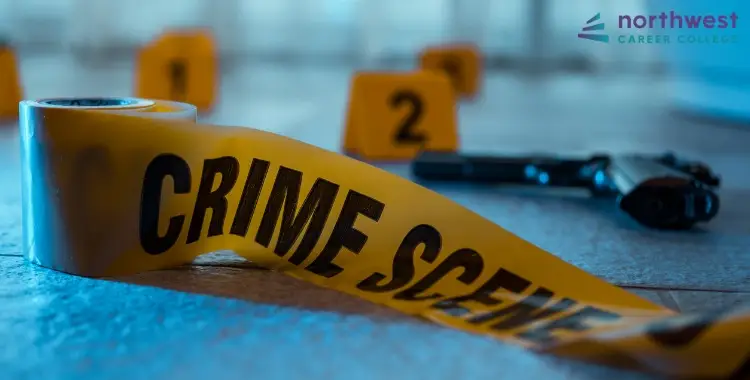The Alphabet of Criminal Justice You Should Know
- Criminal Justice
- April 15, 2025
- 78 views
- 10 min read

Working in criminal justice requires familiarizing oneself with many terms central to understanding how the system works. Some terms may be unfamiliar to the beginning professional; however, they are common in discussions, case work, and reports. Learning the following terms will better equip you and make you more confident as you begin your journey in criminal justice.
Table of Contents
- A – Arrest
- B – Bail
- C – Conviction
- D – Defence Attorney
- E – Evidence
- F – Felony
- G – Grand Jury
- H – Habeas Corpus
- I – Indictment
- J – Jury
- K – K-9 Unit
- L – Litigation
- M – Misdemeanor
- N – Not Guilty
- O – Objection
- P – Plea Bargain
- Q -Quash
- R – Rehabilitation
- S – Subpoena
- T – Testimony
- U – Undercover
- V – Verdict
- W – Warrant
- X – Exhibit
- Y – Youth Offender
- Z – Zoning Laws
- Conclusion: Start Today at Northwest Career College
A – Arrest
An arrest is when a person is taken into custody by the police on suspicion of having committed a crime. The police typically read the suspect’s rights and take him to jail or the police facility for further interrogation. The arrest is a significant part of the criminal justice process and generally represents the first step toward trial or resolution of the case.
B – Bail
Bail refers to the amount a particular individual must pay to be released from jail while waiting for their trial. This money acts as security if one fails to show up in court for their case. In that regard, they will have to forfeit the money. Bail allows someone to go home and await the trial rather than waiting it out in jail. Not everyone merits bail, depending on the severity of the crime.
C – Conviction
A conviction is a sentence imposed on an offender by a law court for committing a particular crime. This could happen upon trial or once the person has pleaded guilty. The convicted person could face fines, probation, and even imprisonment. A conviction marks the end of the trial stage and ushers in the sentencing stage.
D – Defence Attorney
A criminal defense attorney is a licensed attorney who legally represents anyone accused of committing a crime. Therefore, they are responsible for defending a client’s legal rights, advising them on legal matters, and fighting for their innocence or a fair deal. In summary, the defense attorney plays a significant role in the fairness of the trial.
They often work with other professionals, such as investigators, to collect evidence that may help their cases.
E – Evidence
Evidence refers to facts, objects, or information used during the trial to prove guilt or innocence. For example, it could refer to a witness, documents, photographs, and forensic materials like fingerprints. The court will make decisions in criminal cases based on this kind of evidence.
Evidence in the court of law shall be produced legally, reasonably, and considered.
F – Felony
A felony is a serious crime, such as murder, burglary, or drug trafficking. The punishments for felonies are usually graver, such as lengthy prison sentences or heavy fines. They are more serious than those imposed for misdemeanors, which are lesser crimes.
Convictions of felonies tend to have dire consequences: they can hinder employment or result in losing other rights, such as the right to vote.
G – Grand Jury
The grand jury is a group of people who review evidence of the more serious criminal cases and decide whether a person should be indicted or charged with a crime. They are not to determine whether the person is guilty or innocent but instead if it is worth taking that person to trial.
The grand jury operates in the background of criminal justice for cases identified as severe felonies.
H – Habeas Corpus
Habeas corpus is a Latin term that means “you have the body.” A legal action or writ protects a person from false imprisonment. One can approach the court with a habeas corpus petition when the counsel of a person held in custody for no proper reason files it, and this petition thus allows immediate release.
I – Indictment
An indictment is a formal accusation that one has committed an offense. The grand jury usually issues it after reviewing the evidence and deciding that the evidence available is sufficient to charge someone with an offense. An indictment is not an indictment but a step toward a criminal trial. Sometimes, a grand jury indictment is needed to take the case to court, primarily for serious crimes like felonies.
J – Jury
A jury is a body of people selected to hear evidence in a court trial and to give a verdict based on their opinion concerning the guilt or innocence of the person standing trial. A jury’s decision is considered pivotal in any criminal case.
Any criminal case must result in a unanimous verdict, which means that each jury member must agree for such to stand.
K – K-9 Unit
The K-9 Unit is a team of specially trained police officers and dogs employed to execute law enforcement duties. Such dogs are utilized for locating drugs, explosives, missing persons, and other evidence. K-9 units are frequently dispatched to track criminals or hazardous materials.
K-9 officers and their dogs are critical in enforcing the law, especially when the situation becomes complex.
L – Litigation
Litigation describes a process where a case or cause is sued or settled in court. In criminal justice, litigation occurs when an individual is charged with committing a crime, and the case proceeds to trial. The defense and the prosecution present their sides, and then the jury or judge delivers a finding.
The litigation involves all the steps, from pre-trial motions in a courtroom to delivering the final judgment or verdict.
M – Misdemeanor
A misdemeanor is a less severe class of offense than a felony. Examples of common misdemeanors include petty theft, vandalism, and minor traffic offenses. While the sentences are less severe than felonies, a misdemeanor conviction can also result in fines, community service sentences, or short terms in jail.
Most misdemeanors carry sentences of less than a year in jail; many result in no jail time but equally significant forms of probation or other non-jail punishment.
N – Not Guilty
The not-guilty verdict is the decision of either a jury or a judge when the evidence fails to validate the accused’s guilt. This does not mean that the person is ‘not guilty’; it is just that the prosecution did not exceptionally provide sufficient proof beyond a reasonable doubt.
When a person is found not guilty, they are released, and no further legal action can be taken for that specific crime.
O – Objection
An objection is when an attorney, during a trial, says a court rule has been violated. This may be due to improper questions by the other side or evidence that is not allowed. The judge then decides, either allowing the objection or overruling it. Objections are essential to an equitable trial and to ensure that the rules of evidence are observed.
P – Plea Bargain
A plea bargain is an agreement between the defense and prosecution that the defendant will plead guilty to a lesser charge, thus receiving a lighter sentence or escaping some charges against him. Plea bargains are a standard feature of criminal cases and help to avert protracted and expensive trials.
Plea bargains enable both the prosecution and the defendant to dispose of the case without much effort and with reasonable certainty.
Q -Quash
Quash generally means refusing or declaring something null, such as a judicial decision or indictment. If the court is going to quash something, it would mean that it no longer exists. For example, a defense lawyer may request to quash an indictment for an improper matter on the ground of bringing the charge.
R – Rehabilitation
Rehabilitation in the justice system is any program or activity undertaken to aid offenders in reforming their ways and becoming free from crime. These may involve education, therapy, or vocational training to help an individual adjust to society again.
Rehabilitation targets causes of criminal activities, mostly addiction or a lack of education.
S – Subpoena
A subpoena is a legal document given to the person that requires him to appear to the court or to show certain documents. Not appearing or providing the needed documents said on the subpoena has sanctions or penalties. Subpoenas are used to attain witnesses or evidence that is material for the case.
Subpoenas are a warranty that all relevant information and persons avail themselves for trial.
T – Testimony
Testimony can be a witness’s statement or evidence under oath in court. Witnesses give testimonies to help the court understand the facts of the case. The veracity of the testimony is important because it may affect the decisions reached by the jury or judge.
The prosecution and the defense can cross-question the witness to clarify or contradict his/her statements.
U – Undercover
An undercover operation refers to police who secretly and undercoverly investigate various activities against the law. Second, undercover officers may be required to pose as members of criminal organizations to obtain evidence or expose criminal networks; such operations could take time and require the occupants to spend more time in disguise.
Undercover work primarily takes place in Drug Enforcement and Organized Crime Investigations.
V – Verdict
The verdict is the final judgment or decision by the jury or judge in a case, identifying whether the person under accusation is guilty. It ends the trial if the defendant is proven guilty by sentencing them accordingly.
Delivering the verdict is one of the most critical components of the criminal justice process since it denotes the accused’s legal fate.
W – Warrant
A judge issues an arrest warrant and gives police the power to arrest or search property. There are many types of warrants, such as arrest and search warrants, each giving police the power to take legal action.
Warrants protect an individual from illegal searches and arrests, as they have to be sanctioned by a judge.
X – Exhibit
An exhibit is any form of physical or digital evidence brought to court during a case’s trial. Exhibits could be documents, photographs, or objects that prove or support a fact in a particular case. Exhibits are crucial in building up a case because they are tangible evidence the court can observe.
Y – Youth Offender
In criminal law, a young offender is an individual who has not yet attained the age of 18 but has committed a crime. Many crimes committed by a young offender may be judged in juvenile court, not adult courts. The general aim is to rehabilitate, not punish, giving youthful offenders a second chance.
Z – Zoning Laws
Zoning laws specify how land is used in a residential, commercial, or industrial zone. While not precisely a criminal justice term, such land use can have serious legal ramifications, especially for business and property development.
Conclusion: Start Today at Northwest Career College
The Criminal Justice Program at Northwest Career College will help you learn all the necessary skills and knowledge. Enjoy solid training with experienced educators in law enforcement, court systems, and correctional facilities.
Join the many students who have trusted Northwest Career College for an education in criminal justice to help them start their careers.





